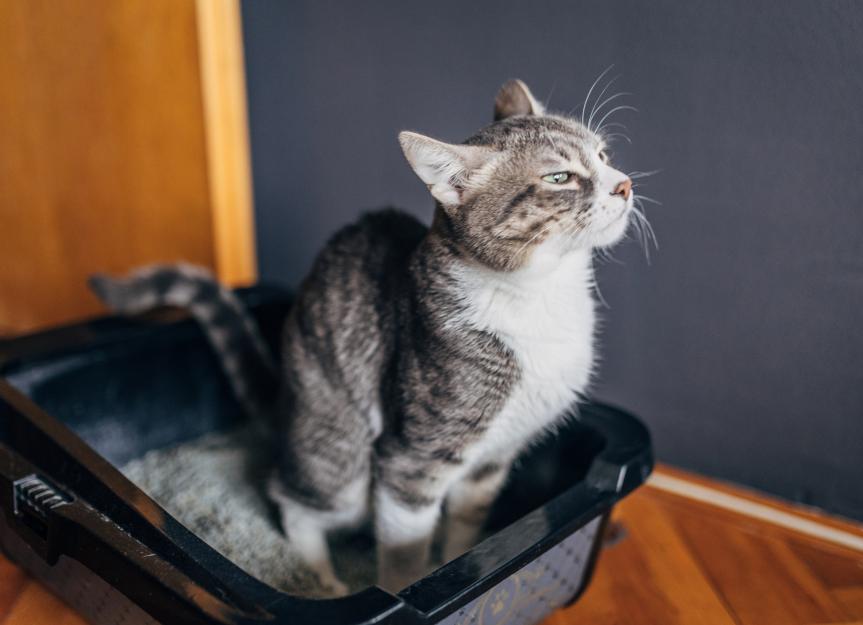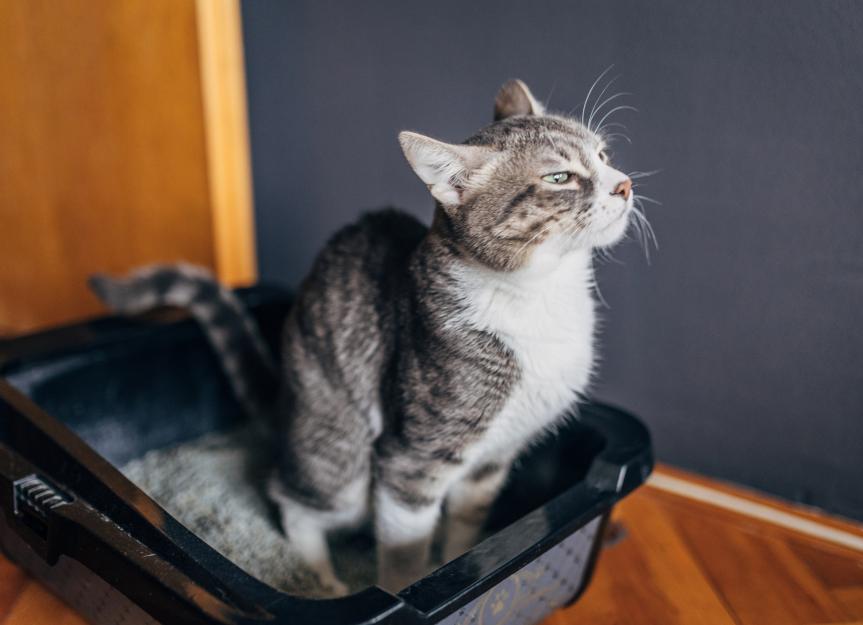
Noticing that your cat can’t pee is understandably alarming.
Veterinarians call this a “blocked cat,” and it’s commonly seen at animal hospitals, especially emergency clinics.
When urine can’t exit the body, waste products begin to build up. This can lead to kidney failure and dangerous electrolyte abnormalities.
Urinary blockages or obstructions in cats are medical emergencies that must be treated by a veterinarian immediately. This condition can be fatal if left untreated.
If you notice any signs of a possible urinary blockage in your cat, call a veterinarian right away.
Key Takeaways
- A cat not peeing is a medical emergency.
- The inability to urinate is most common in male cats because of their long and narrow urethras. However, it’s possible to see this issue in female cats as well.
- Cats who are unable to urinate may vocalize loudly, frequently lick their genital region, or visit the litter box repeatedly.
Why Do Cats Not Pee?
Cats who are unable to pee have something blocking their urethra, which is the small tube that carries urine from the bladder out of the body. When urine can’t pass through, it builds up within the bladder and causes significant pain and inflammation (swelling).
The inability to urinate is most common in male cats because of their long and narrow urethras. However, it’s possible to see this issue in female cats as well.
Problems with urination in cats are generally due to an underlying issue that must be diagnosed by a veterinarian so that the right treatment can be given.
Common Causes of a Cat Not Peeing
Some of the most common causes of cats being unable to pee are:
-
Mucus plugs. This is the main cause of urethral obstructions in male cats. These plugs are made up of mucus, urinary crystals, and inflammatory cells that get stuck within the urethra and block urine from leaving the bladder.
-
Spinal disease. If certain nerves or muscles that control bladder and urethral functions become damaged due to spine issues, a cat may be unable to urinate.
-
Cancer. While rare, cancer can develop within the urethra and lead to an inability to urinate.
Is a Cat Not Peeing an Emergency?
A cat not peeing is a medical emergency.
It must be treated by a veterinarian quickly for the best outcome. Kidney failure and death can happen within just a couple of days if left untreated.
Pet parents should watch for concerning symptoms to figure out whether their cat is having a urinary issue.
Cats who are unable to urinate may vocalize loudly, frequently lick their genital region, or visit the litter box repeatedly. Any blood in the litter box should be noted.
This condition can cause pain and discomfort, so cats may also be restless or even start panting. Your cat may also be lethargic and/or vomit.
When To Call Your Vet About a Cat Not Peeing
If a pet parent notices their cat is not peeing, they should call the veterinarian immediately for guidance.
Do not delay seeking veterinary advice if there are concerns about your cat’s inability to urinate.
How Veterinarians Diagnose a Cat Not Peeing
A veterinarian would start with a complete physical exam.
A blocked cat will have a very full bladder that is easily palpable (able to be felt by touch). The veterinarian will also listen to the cat’s heart to find any abnormalities in rate or rhythm that may have developed due to electrolyte imbalances from the urinary blockage.
Additional tests that will be done if a urinary blockage is suspected include:
-
Blood work. A small sample of blood will be taken to check kidney function, electrolytes, signs of infection, and pH levels.
-
Urinalysis. A sample of urine will be taken using a needle or a catheter to check for inflammation or infection, crystals, abnormal pH levels, and concentration.
-
Imaging. Radiographs (X-rays) or ultrasound can show an enlarged bladder and the potential underlying cause of the obstruction, such as stones or a mass. Imaging is also a great way to find abnormalities within the kidneys.
Treatment for a Cat Not Peeing
Treatment for urinary tract blockages in cats will stabilize the cat and relieve the obstruction. Initial treatment for a cat urinary blockage is done at the veterinary hospital so that a diagnosis for the underlying cause can be made and it can be treated correctly.
Hospitalization is generally recommended during treatment.
Several common treatments for feline urinary tract obstructions include:
-
IV fluids. An IV catheter is placed into the cat’s vein, and fluid therapy is given to rehydrate the cat and restore electrolytes. Additional medications, such as sodium bicarbonate or dextrose, may be added to the IV fluids to restore electrolytes.
-
Muscle relaxants. Medications, such as prazosin, may be given to relax the urethral muscle and allow urine to pass through.
-
Urinary catheterization. Under sedation or general anesthesia, a urinary catheter is gently placed inside the cat’s urethra to dislodge the obstruction and empty the urine. The catheter is kept in place for several days while inflammation within the urethra decreases to prevent re-blocking.
-
Cystocentesis. For some cats, particularly those who are very sick, sedation may be unsafe. Therefore, the bladder may be drained using a small needle that is gently poked through the cat’s abdomen instead.
-
Surgery. If a feline urinary blockage is recurrent, surgically altering the urethra can prevent future occurrences. Additionally, surgery may be needed to remove a mass or a stone that is blocking the urethra.
Once a cat is ready to go home, a veterinarian will likely prescribe any of the following medications:
-
Antibiotics. If a bladder infection is diagnosed, antibiotics, such as Clavamox, will be needed to clear the infection. IV antibiotics may be started while the cat is hospitalized.
-
Diet change. Some cats may benefit from switching to a veterinary diet, such as Royal Canin Urinary SO. These diets are specially formulated to dissolve urinary crystals and prevent urinary stones.
Prevention of the Inability To Urinate in Cats
Long-term management of stress is important to reduce future episodes of urinary obstructions in cats, because stress is a main contributor for both feline lower urinary tract disease and cystitis.
Pet parents can help cats reduce their stress levels by providing plenty of enrichment, such as cat toys and cat trees.
You should always have one more litter box than the number of cats in your household. Place the litter boxes in quiet areas without heavy foot traffic.
Increased water intake can prevent concentrated urine that can lead to a higher risk of blockages. Offering wet food or implementing a water fountain for drinking can be helpful.
Cat Can’t Pee FAQs
What should I do if my cat can’t pee?
If your cat can’t pee, you should see a veterinarian immediately for treatment.
What if my cat hasn’t peed in 24 hours?
See a veterinarian immediately if your cat is having trouble urinating. This condition can be fatal in just a couple of days if left untreated.
How long can a cat go without urinating?
Feline urinary obstructions can be fatal in as little as one to two days.
What is the survival rate for a cat with a blocked bladder?
If treated right away, the survival rate for cats who are blocked is around 90%.
References
George C, Grauer G. Feline Urethral Obstruction: Diagnosis and Management. Today’s Veterinary Practice. 2016;6(4):40-48. https://todaysveterinarypractice.com/urology-renal-medicine/feline-urethral-obstruction-diagnosis-management/



